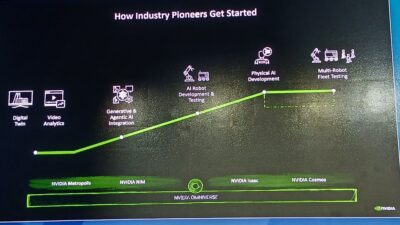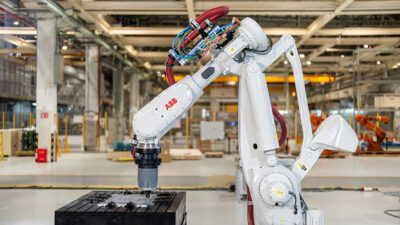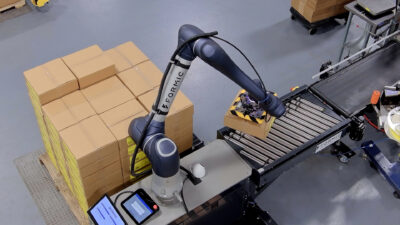Industrial networks are continuing to evolve beyond communication, and are overlapping virtually all areas of control and automation. Three main factors are driving this genesis: applications are tying plant-floor networks to higher-up administration, enterprise, control and/or monitoring systems; devices are being equipped with intelligent functions, including networking capabilities; and hard...
Trends in Industrial Networks
More plant-floors tied to enterprise-level
Devices equipped with intelligence, netwoking
Fieldbuses begin to replace hardwiring
Industrial networks product section
Industrial networks are continuing to evolve beyond communication, and are overlapping virtually all areas of control and automation. Three main factors are driving this genesis: applications are tying plant-floor networks to higher-up administration, enterprise, control and/or monitoring systems; devices are being equipped with intelligent functions, including networking capabilities; and hardwiring is beginning to be replaced with fieldbus-based components and systems.
In late October and early November of 2002, Reed Research (Newton, MA) compiled and analyzed just under 100 qualified responses to a Web-based survey of Control Engineering subscribers, who indicated that they’re involved in specifying, recommending or buying industrial networks. Two-thirds of the respondents to the Control Engineering/Reed Research 2002 Industrial Networking Product Focus Study reported that their primary applications for industrial networks are supervisory control and data acquisition (SCADA) systems.
Meanwhile, networks are used by 38% of respondents for continuous and batch processing; another 38% use them for diagnostics, testing and maintenance; 34% for continuous processing, 24% for motion control and robotics; 21% for machine control and CNC equipment; 11% for discrete product manufacturing; and 5% for batch processing only.
Slightly more than half of the respondents, 51%, report that they use system integrators or third-party consultants to help implement their networks.
Connectivity downs and ups
The respondents add that they presently connect a variety of devices to their networks, but in general slightly fewer plan to do so in the future. [See Present and Future Use chart].
For instance, while 90% of the users now link PLC hardware to networks, only 79% plan to in the next 12 months. Likewise, while 81% now connect network hardware devices, such as hubs, switches and routers, to their networks, only 73% plan to undertake these projects in the future. Also, while 79% now tie I/O products and system to networks, only 71% plan to later.
However, there are some devices that more users plan to connect to networks in the next 12 months. For example, 46% now connect flow sensors, level sensors and/or transmitters to networks, but 49% plan to do so in the future. Also, while 37% now link process analyzers to networks, 41% say they will in the coming year. Notably, vision system hardware components connected to networks are expected to increase from 19% now to 32% in the next 12 months.
In the 2001 survey, present and planned connectivity of devices to networks was generally in the 83-93% range. Results for 2002 may reflect an overall drop in connectivity to networks, but it also likely indicates differences in the two groups of respondents.
Protocol parallels
Similarly, while slightly fewer respondents are connecting devices to networks, fewer also indicate that they’re planning to use most of the well-known networking protocols in the next 12 months. For instance, while 84% report using Ethernet TCP/IP now, only 74% plan to use it in the coming year.
Likewise, while 54% use DeviceNet now, only 46% plan to in the future. In addition, while 37% now use HART, only 27% plan to later. Also, while 47% use Modbus now, 39% plan to in the next 12 months. And, while 30% use Profibus-DP now, 27% plan to in the future.
Only a few protocols bucked this declining trend in networking. Significantly, 15% of respondents report using F OUNDATION fieldbus H1 now, and 17% plan to in the next 12 months. Likewise, 11% now use F OUNDATION fieldbus High-Speed Ethernet, and 18% plan to in the future. In addition, while 9% use AS-interface now, 12% plan to do so. Also, while 29% now use Modbus TCP/IP, 37% plan to use it in the coming year.
Expenditures reported
Spending on networking and related solutions spanned a range of product areas. Respondents stated they spend an average of more than $231,000 on network infrastructures; $120,000 on I/O devices and connectors; $80,000 on network-enabled controllers; $62,000 on wire and cable; $36,000 on network-enabled final control elements; $29,000 on network-enabled sensors; and $27,000 on networking software.
As a result, the respondents expected to save an average of more than $81,000 per year by investing in networking products. They added that these savings needed to be generated in slightly less than 16 months on average.
Intelligence keeps moving
In one of the few trends that continued from 2001 to 2002, the study found that network intelligence will keep on moving from higher-level controllers to lower-level sensors and final control elements. [See Network Intelligence chart.] For example, while 80% of respondents report their network’s intelligence now resides in controllers, only 54% say it will be located there in two years.
However, while only 15% say network intelligence is now located in sensors and transmitters, 32% say it will be located there in two years. Meanwhile, 8% say intelligence is in final control elements now, while 27% expect it to be there in two years.
Industrial network products
For an expanded version of this Product Focus article, visit www.controleng.com. For more information on industrial networking products enter the following numbers at www.controleng.com/freeinfo. For more manufacturer listings, visit Control Engineering ‘s Buyer’s Guide at www.controleng.com/buyersguide .
-Comments? E-mail [email protected]
Industrial Network ProductsGeneral purpose, flat media for DeviceNet
Milwaukee, WI – KwikLink General Purpose Flat Media for DeviceNet from Rockwell Automation is a highly flexible, general-purpose version of its KwikLink flat media. KwikLink general purpose, flat media provides a simple and cost-effective means of bringing DeviceNet to a variety of OEM and high-volume applications. Its low-profile connectors and highly flexible Class 2 cable make it ideal for networking applications in tight quarters.
www.rockwellautomation.com
Rockwell Automation
Ethernet cables for industrial environments
Richmond, IN – Belden Electronics Division’s complete line of DataTuff twisted-pair copper and TrayOptic fiber-optic industrial Ethernet cables help prevent potential data transmission errors and ensure optimum network performance. They’re also designed to withstand exposure to oil and sunlight; temperature variations; abrasion and crushing; and/or the presence of electromagnetic interference (EMI) or radio frequency interference (RFI).
DataTuff includes nine twisted-pair designs, verified to meet Category 5e performance standards and featuring heavy-duty sunlight- and oil-resistant jackets. TrayOptic indoor/outdoor fiber optic series cables include a water-blocking agent and have passed both the IEEE 383 and UL 1581 Vertical Tray Flame Tests. TrayOptic cables use Laser Certified Fiber (LCF) to handle Gigabit Ethernet light sources and any expanded bandwidth requirements.
www.belden.com .
Belden Electronics Division
Components enable hardened Ethernet solutions
North Andover, MA – Connexium hardened network hubs, transceivers, bridges, switches and cables from Schneider Electric provide integrated Ethernet solutions that can unite every part of a facility.
Connexium also features a rugged design, redundant power supplies, and easy DIN rail mounting. While switched networks limit network collisions to deliver determinism, Connexium switches implement SNMP protocol, allowing standard network management tools to monitor and diagnose the network. A Web server embedded in each switch delivers management services that can be accessed by a Web browser.
www.schneiderautomation.com
Schneider Electric
Software manages Profibus, HART
Mannheim, Germany – ABB’s Fieldbus Builder Profibus/ HART is a software component that integrates Profibus- and HART-based field devices in ABB’s IndustrialITcontrol system based on FDT/DTM technology. The tool also allows device access from the control room, saving costs for separate service bus wiring and additional hardware.
Through an open, standardized Field Device Tool interface, Fieldbus Builder integrates devices from any manufacturer. The tool’s Device Type Manager makes device data available to the IndustrialITcontrol system, via a user-friendly graphical interface. New device types can easily be added to the device library.
www.abb.com
ABB
Ethernet infrastructure networking components
Harrisburg, PA – Phoenix Contact recently added Ethernet infrastructure components to its Factory Line networking components. These industrial-grade components consist of redundant intelligent switches, modular hubs and hub agents, network management software, and an Ethernet Inline Fieldbus Coupler.
Factory Line components can be applied on an Ethernet network or integrated into an Interbus automation solution. In both cases, Ethernet cabling and performance can be optimized to meet demands of all industrial automation applications.
Factory Line components are designed for the factory-floor and incorporate interconnection technology that allows easy installation, configuration, and integration into industrial network architectures.
www.phoenixcon.com
Phoenix Contact
Extending field device integration capabilities
Foxboro, MA – Invensys Foxboro’s remote I/O capability maximizes the benefits of HART, FOUNDATION fieldbus, FoxCom, and now Profibus field communications. Invensys uses a new Profibus interface for its Foxboro I/A Series A2 automation system. This interface gives users a cost-efficient option for seamlessly integrating Profibus DP slave devices into a system.
I/A Series fieldbus modules and Foxboro’s exclusive redundant high-speed Ethernet fieldbus network maximize the benefits of Profibus and other smart field protocols by allowing users to securely distribute system I/O remotely in the field to reduce wiring costs.
www.iastore.com www.invensys.com .
Invensys Foxboro
Managed rail switches aid fast-Ethernet connections
Pine Brook, NJ – Managed Rail Switches from Hirschmann Electronics Inc. have a redundant 24-V power supply; can be straightforwardly and rapidly fitted to DIN rails; support Hirschmann’s Hiper-Ring; and offer comprehensive management functions like configuration, performance, security and fault management. They’re also compliant with relevant industrial standards.
Rail Switch RS2-xx/xx has five twisted-pair ports and two fiber-optic ports for multi- or single mode fibers. RS2-FX/FX allows users to implement two fast-Ethernet connections over up to 20 miles, while RS2-FX-LH/FX-LH enables two connections over up to 54 miles. full or half duplex connection.
www.hirschmann-usa.com
Hirschmann Electronics
Ethernet board for CNCs boots tool-to-plant communications
Charlottesville, VA – The 100Base-TX Ethernet card from GE Fanuc Automation provides high-speed communications between Series 15i, 16i, 18i and 21i CNCs and a manufacturing network. The new board offers TCP/IP and FTP Ethernet communications using GE Fanuc’s Focus1/Ethernet interface.
With the new board, data rates are approximately 10 times faster than the CNC 10Base-T Ethernet board. Additionally, concurrent connections have increased from 10 to 20, and the data server option is three times faster than the previous Ethernet board. For compatibility with existing networks, the new board automatically selects 10Base-T or 100Base-TX communications.
www.gefanuc.com .
GE Fanuc Automation



